One of the reasons camping is popular is because it’s looked at as a cheap form of leisure or vacation. But, depending on your style of camping and when and where you go, the cost of camping can actually be quite high.
Here is how the cost of camping breaks down based on latest statistics and a full breakdown of camping costs.
How Much Does It Cost to Go Camping?
On average, campers spend $50 per person, per day on camping trips. This includes campsite fees, activities, sightseeing, and transportation costs. Glamping can cost significantly more, and is often more expensive than a resort. By contrast, camping trips on public land can be completely free aside from transportation and food costs. 1, 2
Note: These costs don’t include camping gear. Gear costs can vary from $170 for the bare essentials bought secondhand to several thousand for new gear and comfort items like camp furniture. Glamping setups can easily cost over $4,000. Gear costs are an investment in camping though; you don’t need to buy it for the next trip.
Camping Costs Breakdown
- Campground costs: $0 to $50+ (per day, per group)
- Transportation: $52 to $348 (per trip)
- Entrance fees, parking, permits: $0 to $35+ (per trip)
- Food: $11 to $60+ (per day, per person)
- Activities: $0 to $100 (per day, per person)
- Firewood: $0 to $15 (per day, per group)
- Gear: $170 to $4,006 (per person; add $55 to $866 for each additional person)
Keep reading for a full breakdown of these costs.
Campground Costs: $0 to $50+ (Per Day, Per Group)
The cost of campgrounds varies drastically depending on the amenities offered. Barebone campgrounds with few amenities are cheaper whereas glamping campgrounds often cost more than resorts.
Campgrounds near popular scenic destinations like the Grand Canyon can be very expensive. Rates are usually cheaper in the low season. In the peak season, cheaper campgrounds get booked quickly leaving you with fewer budget options.
If you are an experienced camper, you can skip the campground costs completely. There are plenty of places to go free camping. Or, you might try backpacking instead. In many National Parks, backpacking is free or only requires a small permit fee. 3, 4, 5
Campground Costs (Per Night, Per Person)
- Basic Campsite: Barebone campsites with few amenities cost around $15 to $25 per night.
- Campsite with Amenities: Expect to pay $20 to $40 per night for amenities like electrical hookups, WiFi signal and dishwashing stations.
- RV Camp: $25 to $60 per night
- Glamping: $50+ per night. Cost may be per person.
*Note that some campgrounds charge per tent whereas others charge per person. Some campgrounds even charge per person and have a separate tent fee.
Read Next: How to Choose a Campground
Entrance Fees, Parking and Permits: $0 to $35+
If you want to go camping in a National or State Park, you will likely need to pay entrance fee. The fee can be as low as $3 per person in less-popular parks, though you will likely also need to pay for parking as well.
In popular destinations like Yellowstone, Grand Teton and Zion, the entrance fee is $35. However, this fee is per vehicle and not per person. The more people there are in your group, the more affordable it becomes.
Some activities may require you to get a permit. For example, bear viewing in Alaska’s Tongass National Forest will cost you $50 in peak season. A Grand Canyon Backcountry permit will cost $15 per night plus a $10 charge. A climbing permit is just $6 for the entire group in Acadia Otter Cliffs.
The good news? A lot of camping spots don’t require any entrance fees – especially if you are wild camping on public land. 6, 7, 8
Transportation Costs: $52 to $348
In 2023, nearly 1/3 of campers saved money on their trip by camping close to home. On average, campers only traveled 179 miles from home to their campsite. It’s rare for campers to buy airline tickets with only 7% of campers flying for a camping trip in the previous 3 years.
However, road trips are popular with campers. An average camping road trip covers approximately 1,200 miles.
According to CNET, when you factor in gas and maintenance, it costs 29 cents per gallon to travel by automobile. This comes out to approximately $52 to $348 in transportation costs for a typical camping trip.
Food: $11 to $60+ (per day, per person)
If you bring all of your own food camping, the costs can be as little as $11 per person, per day –the same cost as eating at home.9, 10
If you want the convenience of prepared meals though, your camping food costs will be much higher. Eating freeze-dried foods for most of your meals will cost approximately $33.00 per day. Add in a few restaurant meals or snacks from the campground commissary and you can easily spend more than $60 per day on food.
*Not sure what to eat while outdoors? I’ve written an eBook with over 50 dehydrator recipes for camping, plus tons of advice on meal planning.
Learn more here. Or buy it now.
Activities: $0 to $100 per day
On any vacation, activity costs can add up quickly. For example, horseback riding typically costs $75 to $100 per person. Doing one of these activities per day will increase your budget greatly! Renting boats, bikes or quad bikes also tends to be pricy. However, there are also lots of free camping activities like stargazing, hiking and campfire cooking.
Firewood: $0 to $15 per day
A lot of campgrounds and parks forbid you from gathering your own firewood. You shouldn’t bring firewood from home either because it could cause non-native species of insects, fungi or bacteria to enter the ecosystem.
That leaves you with paying for firewood. It typically costs $5 for a bundle of firewood and a large, social campfire will require three bundles.
Camping Gear Cost: $170 to $4,006 (add $55 to $866 for each extra person)
Camping gear can be notoriously expensive. For example, a rooftop tent can easily cost over $2,000. However, most cheap gear is fine for camping in good weather conditions. My old $50 tent even survived a hail storm on at 6,000 feet!
If you stick to just the essentials and buy gear in secondhand stores or outlets, you’ll find that camping gear can be very affordable. It’s hard to find everything you need secondhand though, so budget for some full-priced items. If you want high-tech or luxury gear, the costs can quickly spiral out of control.
Gear Costs:
- Just the essentials: $170 for cheap secondhand gear. Up to $1,540 for higher-end new gear.
- Essentials plus some comfort items: $260 to $2,910
- Glamping setup: $455 to $4,006
A lot of camping gear can be shared between members (such as the tent or the stove), so you only need to buy one of these items. There is some gear that each person on the trip will need to have their own of (such as headlamps or backpacks). For this, add $55 (low end) to $866 (high end) per each additional person.
Even if you do buy opt for expensive gear or “luxury” items, remember this:
Camping gear is a ONE-TIME INVESTMENT.
Once you’ve bought the gear, you won’t have this cost for your second camping trip. The more you go camping, the better your investment pays off.
Tip: Check out REI’s “Garage” for massive discounts on last season’s camping gear.
Essentials
Tent: $50 to $600
It’s fairly easy to find cheap camping tents. You can often even find them at garage sales or flea markets. Just be careful about buying a very cheap tent or a used one that has undergone a lot of abuse. The weather can change quickly when camping and you don’t want to end up suffering in a tent that doesn’t handle rain or wind well!
If you want a larger tent with lots of headroom and a screened area for hanging out, expect to pay a lot more. Budget options are available but they usually don’t handle the elements well.
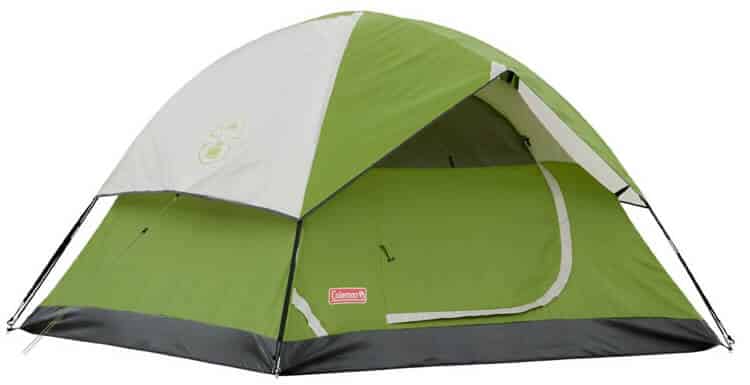
This 4-person Coleman tent is great if you want quality on a budget. Check out tents on REI here.
Sleeping Bag: $20 to $100
This is another item which is easy to find for very cheap. Just pay attention to the “comfort rating” on the sleeping bag. It can get cold at night when camping (even in summer!) so you need a sleeping bag suited for the climate.
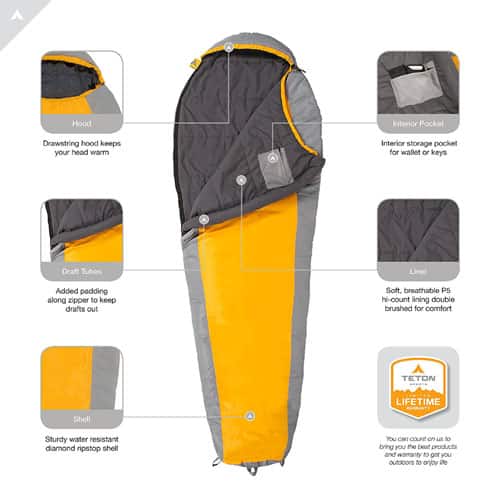
This sleeping bag by Teton weighs in at under 3lbs, is rated to 20F, and is affordable. Get it here.
Sleeping Pad, Mattress or Cot: $10 to $150
If you use a cheap foam sleeping bag, you probably won’t spend more than $10. Air mattresses are more expensive and prone to popping, so you’ll need to invest in some repair tape too. Cots also tend to be pricier and it’s tricky to find them on secondhand sites.
Kitchen: $30 to $200
At the bare minimum, your camp kitchen will consist of a stove, fuel and cook set. Camp stoves range from ultra-cheap canister stoves to more advanced propane stoves with multiple burners. Expect to pay $30 to $150.
The cook set doesn’t have to cost anything if you just bring your normal cookware from home. Even if you choose to buy a set, it probably won’t cost more than $50.
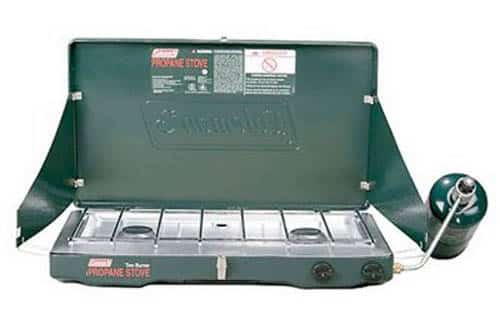
This Coleman stove runs on propane. It is an affordable option and you can buy it here.
Backpack with Rain Cover: $10 to $200
You’ll need a backpack for carrying things around camp or for going on day trips. Ideally, it needs to have a rain cover so you can keep items inside dry. A cheap backpack with a trash bag liner will work and cost almost nothing. On the high-end, you can buy hiking daypacks with lots of features like attachment hooks, water bladders and lots of pockets.
First Aid Kit: $20 to $75
Building your own first aid kit can be as cheap as $20. To buy a pre-made camping first aid kit, you’ll spend around $75. Here’s a complete camping first aid checklist.
Light and Power: $25 to $200
At a minimum, each person in your group will need a flashlight or headlamp when camping. A lot of people also bring lanterns or other camp lights. They are useful if camping in a group so you can illuminate a larger area. The good news is that you only need one lantern per group, not per person.
If the campground doesn’t have an electric hookup, you will need lots of extra batteries and/or a power bank. Solar power stations are popular for long-term camping, but these are very pricy and probably not necessary for beginner campers.
Rope: $5 to $15
You need this for a laundry line, fixing broken shoelaces, hanging a bear bag, and a zillion other things. Paracord is a good, all-purpose rope to buy.
Probably Essential Gear
Water Containers: $0 to $70
Unless you want to haul water back and forth from the campground spigot all day long, you’ll need some larger jugs for holding water. This can cost absolutely nothing if you bring recycled bottles from home. You’ll have a better camping experience if you get a water container with a spigot though. These cost around $25 to $35 each and you may need two (or more) of them for your group.
Dishwashing Basins: $0 to $60
For washing dishes, you’ll need three basins. You can use whatever you have at home. Or, to make camping life easier, buy some collapsible portable sinks with drains. These range from $10 to $20 each.
Table and Chair: $30 to $290
If you don’t want to sit on the ground and would like a dedicated area for cooking and eating, you’ll at least want to bring chairs and a table or two. These items will only add about $30 to your budget if you choose basic items.
As you start getting into more luxury camping furniture, the costs can skyrocket. For example, there are camp rocking chairs which cost $140+. Some folding tables even cost $150+.
Shelter: $15 to $300 per group
In addition to your sleeping tent, you may want another shelter. For example, you can set up a cheap $15 tarp to make a shady area or protect against the rain. Some people like to buy mesh tents – aka screen houses — so they have a place to hang out away from mosquitoes. These can be found for $50 to $100 but some cost upwards of $300.
Cooler: $20 to $500
If you want to bring any perishable foods or have cold drinks, then you will need a cooler as well. These range from ultra-cheap soft-side coolers that cost as little as $20 to hard-side coolers with advanced insulation that can easily set you back $300. If you opt for a 12v camp refrigerator, expect to pay at least $500.
Water Treatment System: $25 to $150 per group
You might not need this if your campground has safe drinking water, but a water treatment system is great to have if you go on hikes or are wild camping. I use the Sawyer Mini and it is one of the cheapest filters of its kind. There are other options too, like UV filters, water purification tablets, and larger filters. Read this guide to choosing a camping water filter.
Optional Gear
Shower Setup: $30 to $270
If you want to avoid the campground bathroom, you can set up a shower station. A pop-up privacy station will cost anywhere from $20 to $140. You can find cheap solar showers for as little as $10 and more advanced ones with pumps cost upwards of $140.
Bear Canister: $40 to $76 per group
A lot of campgrounds in bear territory require you to keep food in a bear canister or use their food lockers. These canisters will likely cost you at least $76. If you get lucky, you can find a used one for sale for around $40.
Portable Cook Station: $70 to $250
For long-term camping or when camping in a large group, it’s really useful to have a dedicated cooking station. The cheapest ones are around $70 and more advanced ones with cabinets and hooks can cost $250.
Hammock: $20 to $300
A basic hammock doesn’t have to be expensive and they are fairly easy to find on secondhand stores. If you want a hammock with a stand so it doesn’t have to be strapped to trees, expect to pay upwards of $300.
Fire pits: $35 to $200
A lot of campgrounds require you to use a fire pit for campfires. If you only need a small campfire, then a cheap fire pit costing around $35 will suffice. Deluxe fire pits that can also be used as grills will cost $200+.
How much do you spend on camping? Let us know in the comments section below!


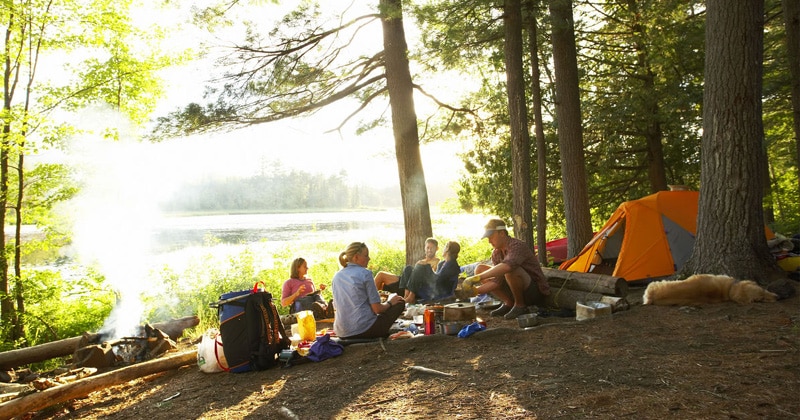
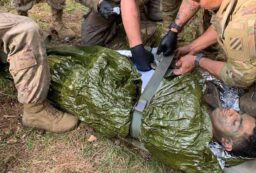
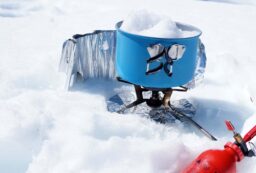
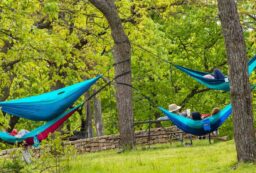






Post your comments